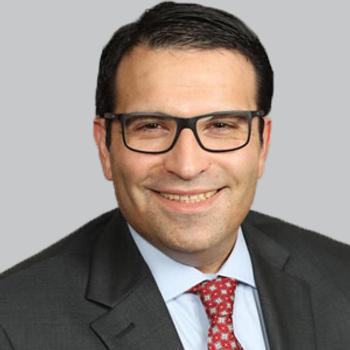
Soticlestat Meets Primary End Point in Dravet and Lennox-Gastaut Syndromes
The first-in-class CH24H inhibitor was associated with a reduction in seizures and seizure frequency in an early analysis of the phase 2 ELEKTRA study, with plans to initiate the move to phase 3 in Dravet syndrome.
Amit Rakhit, MD, MBA
Ovid Therapeutics and Takeda Pharmaceuticals have announced topline results from the phase 2 ELEKTRA study of soticlestat in children with Dravet syndrome (DS) or Lennox-Gastaut syndrome (LGS). Ultimately, the data were positive, suggesting that the first-in-class cholesterol 24-hydroxylase (CH24H) inhibitor can reduce seizures in these patients.1
The primary end point for soticlestat—the reduction from baseline in convulsive seizures for the DS group and drop seizures in the LGS group—was met with statistical significance. Based on data from an efficacy set of 120 patients during the maintenance phase, there was a 27.8% median reduction overall compared to the placebo group’s 3.1% median increase over 12 weeks (median adjusted reduction, 30.5%; P = .0007).
“We are extremely encouraged by these results, which show a clear statistically significant reduction of seizures in Dravet syndrome patients treated with soticlestat, as well as a trend for seizure reduction in Lennox-Gastaut patients,” said Amit Rakhit, MD, MBA, president and chief medical officer, Ovid, in a statement. “We look forward to continuing our collaboration with Takeda to initiate a Phase 3 registrational program for soticlestat in patients with DS, while continuing to analyze the data from patients with LGS in the ELEKTRA and ENDYMION studies to define potential next steps.”
ENDYMION is the open-label extension to ELEKTRA, designed to assess the long-term safety and tolerability of soticlestat over 4 years of treatment in patients with rare epilepsies and to evaluate the effect of soticlestat on seizure frequency over time. Data from the ELEKTRA patients who have rolled over into the ENDYMION study are supportive of results in the core study. Ovid noted that those findings indicate maintenance of effect over 6 months in those originally randomized to treatment, and similarly reduced seizure frequency as compared to baseline in those patients previously assigned to placebo, without new safety signals.
A total of 141 patients were enrolled in ELEKTRA and 126 completed the study. A modified intent-to-treat (mITT) analysis of 139 patients was performed to evaluate the efficacy endpoints, which includes any patient who enrolled in the study and received at least one dose of study drug.
READ MORE:
Drop and convulsive seizure frequency for patients with LGS and DS was also reduced with soticlestat, with a 29.8% median reduction compared to 0% in the placebo group over the 20-week titration plus maintenance period (adjusted reduction, 25.1%; P = .0024).
When assessing its performance by disease, the patients in the DS cohort (n = 51) who were treated with soticlestat experienced a median reduction of 33.8% in convulsive seizure frequency compared to a 7% median increase for placebo (median adjusted reduction, 46%; P = .0007). In the LGS cohort (n = 88), soticlestat-treated patients demonstrated a 20.6% median reduction in drop seizure frequency compared to a 6% median reduction for placebo (adjusted reduction, 14.8%; P = .1279).
Ovid and Takeda noted that based on the data from ELEKTRA, they plan to meet with regulatory agencies to move toward phase 3 in DS, while additional analyses are conducted to understand the next steps for the development of soticlestat in this the LGS patient population.
“Children with developmental epileptic encephalopathies like DS and LGS need more options to manage their treatment-resistant seizures,” said Cecil Hahn, MD, MPH, child neurologist, The Hospital for Sick Children, and associate professor of pediatrics, University of Toronto, in a statement. “The results of the ELEKTRA study are very promising, particularly for children with DS and represent a clinically significant reduction in seizure burden. Moreover, soticlestat was well-tolerated in this study."
ELEKTRA included pediatric patients aged 2 to 17 years and consisted of a 4- to 6-week screening period for baseline seizure frequency, followed by a 20-week double-blind treatment period, which included an 8-week dose optimization period and a 12-week maintenance period. Patients were titrated from 100 mg twice daily (BID), to 200 mg BID to 300 mg BID (mg/kg dosing for patients <60 kg) of orally administered soticlestat.
Patients in the study were allowed to be on 1 to 4 concomitant anti-epileptic drugs (AEDs), with the majority of patients concomitantly treated with at least 3 AEDs. The most common AEDs taken by the patients were valproate, clobazam, levetiracetam and topiramate.
These data are not the first analysis of soticlestat as a seizure treatment, with
ARCADE is a still ongoing, multicenter, open-label, pilot study (NCT03694275) of soticlestat in patients ages 2 to 55 with refractory epileptic seizures associated with CDD or Dup15q. Started in September 2018, the study is investigating the frequency of motor seizures in 30 patients who receive soticlestat twice daily and will consist of 2 periods.
“We also expect to report data from the open-label phase 2 ARCADE study with soticlestat in patients with CDKL5 deficiency disorder and Dup15q syndrome, 2 other types of highly-refractory DEEs, later this quarter,” Rahkit added in his statement.1
REFERENCES
1. Phase 2 ELEKTRA Study of Soticlestat (TAK-935/OV935) Meets Primary Endpoint Reducing Seizure Frequency in Children with Dravet Syndrome or Lennox-Gastaut Syndrome. News release. New York, NY; Osaka, Japan. Ovid Therapeutics; Takeda Pharma. Published August 25. 2020. Accessed August 25, 2020. https://investors.ovidrx.com/news-releases/news-release-details/phase-2-elektra-study-soticlestat-tak-935ov935-meets-primary
2. Ovid Therapeutics announces initial data with soticlestat in CDKL5 deficiency disorder and Dup15q syndrome. News release. New York, NY: Ovid Therapeutics; Published March 30, 2020. Accessed August 25, 2020. finance.yahoo.com/news/ovid-therapeutics-announces-initial-data-120010372.html
Newsletter
Keep your finger on the pulse of neurology—subscribe to NeurologyLive for expert interviews, new data, and breakthrough treatment updates.


































